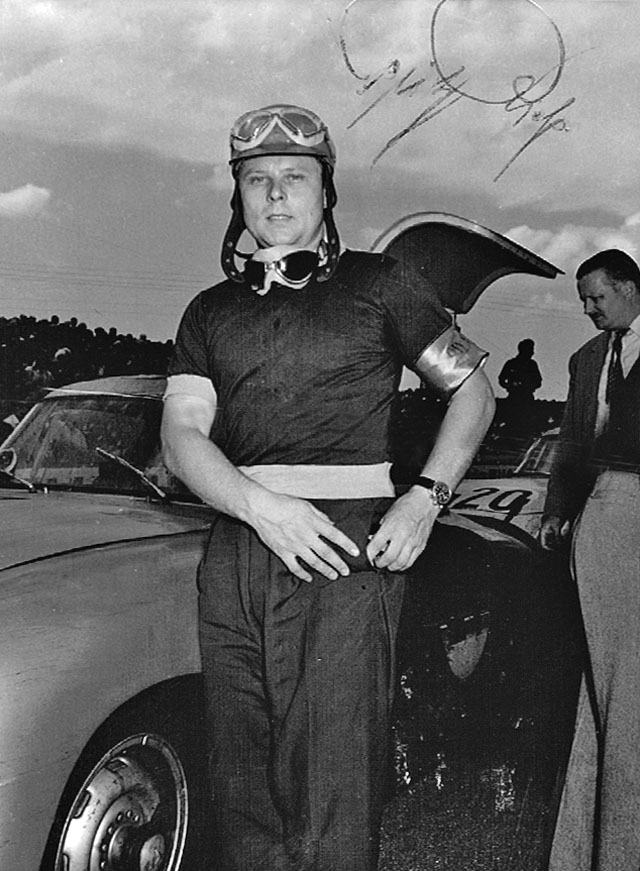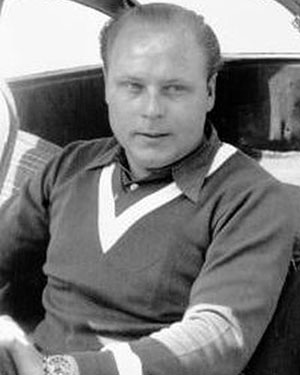Fritz Riess or Rieß (11 July 1922 in Nuremberg – 15 May 1991 in Samedan, Switzerland) was a racing driver from Germany.
He participated in one Formula One World Championship Grand Prix, on 3 August 1952. He finished seventh, scoring no championship points as only the first five finishers scored points at that time.
Riess also won the 1952 24 Hours of Le Mans for Mercedes-Benz, sharing the drive with Hermann Lang. Info from Wiki
![]()
Fritz Riess: 1952 Formula One Season By Jeremy McMullen
The hero usually has a sidekick that fails to get much of the credit, but usually is the one that helps the hero when all hope is gone. Fritz Riess is one of those men in racing history that most fail to remember. But list the names that had competed against him, or, that had driven with him at different times and it reads like a hall of fame roll-call.
The list is impressive. Ascari, Farina, Lang, Collins, Taruffi and Trintignant were all famous names to have either competed against, or, driven with Riess at some time or another. What’s more, many times Riess bested those on the list that had competed against him. To say that Riess was good would be to insult the man. However, there always seemed to be others around him, at the same time, that were great.
Riess, who was born in Nuremberg, Germany in 1922, would really come onto the racing scene in the later part of the 1940s. While taking part in sports car and Formula 2 races, he would be successful right away. In 1949, he would come away with numerous top ten, top five, top three results. He would even manage to win a couple of races. He was good. The problem for him was that, due to World War II, he wasn’t allowed to really race anywhere outside of Germany.
Then, in 1950, the restrictions were eased a good deal. This allowed Fritz to travel to some other races. Feeling the sensation of freedom, Riess would celebrate the easing of the restrictions by winning a number of races, including the Eifelrennen held on the 14 mile long Nordschleife. Just about every circuit he would go to he would either win or finish on the podium. Because of the restrictions Riess had grown accustomed to the circuits all around Germany. As a result, the Nordschleife seemed to become a personal playground for him. Many of the others were like second nature to him as well.
Fantastic results continued to come to Riess throughout the rest of 1950 and all the way through 1951. Then, ahead of the 1952 racing season, an opportunity for Riess, and many other German drivers, would come along. War-torn Germany was in no shape to truly assemble a factory Formula One team in the first couple of years of the World Championship. On top of it all, despite the ease of travel restrictions, Germany’s money was practically worth zero. This made travelling around Europe to participate in grand prix races not a very economical idea. However, there were some individuals that would manage to go to a couple of races here and there, but still not that far away from Germany.
Then things changed. The incredible costs of grand prix racing were already becoming too much. This helped to lead Alfa Romeo to decide to pull out at the end of the 1952 season. With costs ever-increasing, and no competition for Ferrari, race organizers and the World Championship governing-body were left in search of an alternative. The alternative would be running races according to Formula 2 regulations. Formula 2 costs were less than Formula One, and, the racing had proven to be rather competitive. In the case of many of the German racers, this was a means in which to take part in the World Championship.
After the war, small factory efforts like Veritas and AFM came into existence. Germany also had the proven BMW 328 engine at its disposal. These ‘tools’ made it possible for German racing to rise out of the ashes. Heading into 1952, these ‘tools’ wouldn’t just enable German racers to take part in some local races, the change in regulations would enable German teams and drivers to enter a world stage. Drivers, like Riess, would take advantage of the opportunity.
Although the opportunity would come, Riess, like many other German drivers, would start, and carry on, his season rather close to Germany. His first grand prix race would come on the 11th of May. The first race took place just to the south of Dessau and it was the 1st Dessau Autobahnspinne.
The race was reasonably short as it was only 16 laps of the 3.10 mile circuit and totaled only fifty miles. The circuit itself, located south of Dessau, utilized a small portion of the autobahn that ran between Berlin and Leipzig. A road bridge crossed over the usually busy autobahn and provided spectators with an incredible view. From this vantage point a good percentage of the race could be seen. The circuit ran south down the autobahn, and then, turned at a hairpin turn and ran back north toward Berlin. The circuit then turned off into a small portion of the heavily wooded Mosigkauer-Heide. The circuit then made another, more gentle, hairpin turn and headed back to the highway.
The race at Dessau was a relatively minor race that was also on the same day as the Gran Premio di Napoli and the day after the BRDC International Trophy race. Therefore, the field was rather light of international competitors. And of the competitors present, the majority were using BMW chassis and engines that were quite a few years old.
Fritz Riess would arrive at the race with a Veritas-Meteor. This chassis had proven to be quite good, even in competition against other, more international, chassis. The advantage competitors, like Riess, had with the Veritas was, very simply, the fact the chassis and engine had been built in the post-war era. This meant the car was more capable of handling the stresses compared to a pre-war design.
Heading into the race, Riess was not the favorite to win. He would again be eclipsed by another, the German Paul Greifzu. Unfortunately for the fans who came to watch Greifzu, they would be witness to a dark moment at Dessau.
Greifzu was beloved not merely because he was an incredible amateur driver, but also, because he was the only driver that had built his own chassis design and had it win a major race. Greifzu, who initially stated he would not come to Dessau, would come out on the track behind Riess during practice. The home-built car Greifzu had around him would power its way past Riess within just a couple of laps. This was Riess’ main competition and it looked to be shaping up into a real battle between East and West Germany. However, it would all tragically come to an end after only 4 laps of practice.
Heading down the long straight, Greifzu’s engine suddenly seized. Lost in a thick cloud of smoke, the car spun and crashed into a grandstand. The car was all bent up. The steering wheel was warped out of shape due to the velocity of the crash. Just like that Greifzu was dead. So too was the expected battle between himself and Riess.
With Greifzu’s death, only nine would end up taking the green flag for the start of the 16 lap race. Not to soon into the race, those with older chassis designs and engines, began to drop out of the race. Josef Peters and Willi Heeks were the first to retire from the race. Another BMW 328-powered car, driven by Kurt Straubel, would also retire. In all, five of the nine would fail to finish the race.
The race, too, failed to make it. Greifzu’s death left a void in the competition department. Driving his Veritas-Meteor, Riess would turn the fastest lap of the race and would cruise to the victory. Theo Helfrich and Rudolf Krause would come in a rather distant 2nd and 3rd. The West German driver had come into East Germany and had dominated, and yet, the race would be more remembered for the unfortunate driver who died that weekend.
and next about this driver Page 2 Page 3 Page 4





